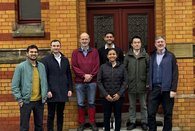Combination of Space Geodetic Techniques
The high-accurate International Terrestrial Reference Frame (ITRF) is the metric basis for quantification with respect to Earth surface and essential for many theoretical and practical applications, such as the quantification of sea surface height and its change. To achieve the GGOS (Global Geodetic Observing System, main project of IAG – International Association of Geodesy) requirements for ITRF of 1 mm accuracy and 0.1 mm/year stability, a rigorous combination of the space geodetic techniques with local ties is necessary. Local ties are coordinate differences between reference points of sensors at co-location sites. As ties are essential for the combination of space geodetic techniques, we develop and exploit new and established ties, including global ties (common EOP), local ties, space ties (common precise orbit determination of LEO and MEO satellites), tropospheric ties, and clock ties. Our research involves new methods and innovative techniques for the best possible multi-technique integration for the realization of consistent TRF, CRF (Celestial Reference Frame), and EOP (Earth Orientation Parameters).
Depending on the frequency, signals observed at the same time and in the same direction are affected likewise by atmospheric refraction, e.g. microwave-based (GNSS, VLBI, DORIS) or optical space geodetic techniques (LLR, SLR). Hence, this allows the determination of common tropospheric parameters, i.e. delays and horizontal gradients. To exploit that, tropospheric ties have to be assessed and applied. Evidently, employing tropospheric ties in multi-technique combination can improve solutions, particularly those of techniques featuring limited or defect observation geometries or insufficient temporal coverage. For example, we have shown that tropospheric ties can enhance VLBI estimates in integrated GNSS-VLBI-analyses, and VLBI-VLBI co-locations as demonstrated by improvements in baseline length repeatability and other parameters.
Besides the combination, the working group is particularly concerned with geodetic and astrometric VLBI data analysis.
Very Long Baseline Interferometry (VLBI)
Very Long Baseline Interferometry (VLBI) is a highly accurate technique, used since the 1970s in astrometry (positional astronomy) and geodesy. This technique allows scientists to measure distances up to about one Earth diameter with an accuracy of a few millimeters. Thus, VLBI contributes significantly to the ITRF, in particular to its scale and stability. It is the only space geodetic technique referring to the space-fixed International Celestial Reference Frame (ICRF) and the only one that provides the full set of Earth Orientation Parameters (EOP): polar motion, Earth Rotation Angle (ERA), which is linearly proportional to the mean solar time UT1 (Universal Time 1), and celestial pole coordinates.
In VLBI, several radio telescopes spread worldwide observe the same object in the sky at the same time. Figure 2 illustrates a single observation. The received radio signals are processed, digitized, and finally recorded together with the frequency obtained from exact frequency standards (hydrogen maser), and sent to a dedicated computing facility called correlator. By comparing the measurements in a process called ‘cross-correlation’ the time difference between the arrivals of the signal at each two stations is determined. With this information the baseline, the three dimensional vector between the stations, can then be derived with an accuracy of a few millimeters. For astrometric purposes, the same method is used to obtain the spatial directions to the radio sources with an average precision of about 40 microarcseconds (about ten billionths of a degree). This corresponds to measuring the exact location of a tennis ball on the Moon as seen from the Earth.
The positions of the VLBI stations contribute significantly to the realization of the global terrestrial reference frame (ITRF). The stable reference points provided by VLBI are ideal for surveying the Earth to determine changes with high precision. These changes are based on phenomena such as global sea level change and tectonic plate motions. The results obtained from VLBI measurements are very revealing. Figure 3 shows how the stations in Westford (US-Ma) and Wettzell (Germany), separated by about 6,000 kilometers, slowly move apart by about two centimeters per year due to plate motion. The decreasing scatter in the measurements toward more recent years is due to technical progress and improvements made to the VLBI technique.
![[Translate to English:] Two sites located in the United States (Westford) and in Germany (Wettzell) are drifting apart due to plate motion](/fileadmin/_processed_/1/a/csm_fig3_VLBI-westford-wettzell_739d8d4c80.png)
In the analysis of VLBI measurements several disturbances have to be considered. For example the atmosphere “slows” the radio waves down, especially in the lowest layer the troposphere, about ten kilometers high, where weather takes place. But it is not just an effect that has to be corrected when analyzing VLBI data. VLBI also allows to determine meteorological parameters from its observations. The tropospheric information obtained by VLBI over long periods provides important insight about the atmospheric water vapor contributing to Earth's climate in terms of a greenhouse gas. The rotational fluctuations of the Earth itself must also be considered: the continuous changes of the location of the Earth's pole (polar motion) and the slight variations in the length of day (LOD). Through precession and nutations the Earth rotation pole varies with respect to the space-fixed frame as well.
VLBI typically observes natural extra galactic radio sources (active galactic nuclei, AGN), such as quasars (Fig. 4), active radio galaxies, and BL Lac objects. Employing the same ground segment, galactic radiostars and artificial radio sources can be observed with VLBI. This enables the observation of satellites and space probes. In the process of extending the geodetic VLBI technique for measurements of spacecraft, technical requirements have to be fulfilled and appropriate theoretical VLBI models have to be utilized. The observation of phases, e.g. with the method of differential VLBI (D-VLBI), aka phase referencing, is also of interest for such applications.
In addition to aiding the navigation of space probes and the determination of spacecraft ephemerides, VLBI observations can be used to derive Earth satellite orbits and to link different reference frames and different geodetic observation techniques. The Combination and VLBI group at GFZ examines these and other applications, where the connection between the reference frames of VLBI and Gaia (ESA astrometric satellite mission) and GNSS (Global Navigation Satellite Systems, Fig. 5) are of particular interest.
Combination and VLBI Group Members
Members (in alphabetical order):
- Georg Beyerle (Dr.), Development of software for geodetic/astrometric VLBI data analysis
- Sujata Dhar(Doctoral Student), DFG Project “AGORA”, Prediction of Earth Orientation Parameters, Simulations, Combination of VLBI and GNSS
- Robert Heinkelmann (Dr.), Head of Combination and VLBI group, GFZ IVS Analysis Center Representative, Global Reference Frames, analysis and validation of Earth orientation parameters, tropospheric and ionospheric parameters
- Shrishail Subash Raut(Doctoral Student), DFG Project “NextGNSS4GGOS”
- Patrick Schreiner (Doctoral Student), DFG Project “NextGNSS4GGOS”
- Vishwa Vijay Singh (Dr.), DFG Project “AGORA”
- Jungang Wang (Dr.), DFG RU “Clock metrology”
MSc Students (in alphabetical order):
- Shashank Pathak (TU Berlin, Master of Space Engineering MSE)
- Partist Poopat (TU Berlin, Geodesy and Geoinformation Science)
- Edgar Tamarian (TU Berlin, Geodesy and Geoinformation Science)
PORT: Potsdam Open-source Radio interferometry Tool
PORT (Potsdam Open-source Radio interferometry Tool) is a software package dedicated to the analysis of modern and historical very long baseline interferometry observations (VLBI). PORT is being developed at GFZ Potsdam and is utilized to perform the GFZ VLBI Analysis Center responsibilities, as well as state-of-the-art research in the field of space geodesy, geophysics, and astrometry. PORT can estimate quantities such as station positions, quasar positions, Earth orientation parameters, atmospheric delay parameters, either employing weighted least-squares or a Kalman filter and smoother. PORT is designed to process VGOS observations, as well as traditional S-/X-band and single-band observations, regardless of data length; PORT processes both Intensive and multi-hour/day sessions. Developing PORT, special care has been taken to deal with issues such as the source structure. PORT abides by the latest analysis standards suggested by the IERS (International Earth Rotation and Reference Systems Service) and the IVS (International VLBI Service for Geodesy and Astrometry), and is ITRF2020-ready.
PORT is written mainly in MATLAB, with some Python modules, and is maintained on a Git server. VLBI data analysis employing PORT may be carried by scripting or interactively via a graphical user interface.
Upon completion, PORT will be able to schedule, simulate, and analyze VLBI observations, as well as to utilize VLBI observations to derive consistent terrestrial and celestial reference frames.
For more information about PORT, please visit https://git.gfz-potsdam.de/vlbi-data-analysis/port
If you need additional information, please contact Georg Beyerle.
Schuh et al.: The Potsdam Open Source Radio Interferometry Tool (PORT), Publications of the Astronomical Society of the Pacific, 133:104503 (13pp), 2021, https://doi.org/10.1088/1538-3873/ac299c
Recent publications
Śliwińska-Bronowicz, J., Kur, T., Wińska, M., Dobslaw, H., Nastula, J., Partyka, A., Belda, S., Bizouard, C., Boggs, D., Bruni, S., Chen, L., Chin, M., Dhar, S., Dill, R., Ferrandiz, J. M., Gou, J., Gross, R., Guessoum, S., Han, S., Heinkelmann, R., Irrgang, C., Kiani Shahvandi, M., Li, J., Ligas, M., Liu, L., Lu, W., Mayer, V., Michalczak, M., Modiri, S., Otten, M., Ratcliff, T., Raut, S., Saynisch-Wagner, J., Schartner, M., Schoenemann, E., Schuh, H., Soja, B., Su, X., Thaller, D., Thomas, M., Wang, G., Wu, Y., Xu, X., Yang, X., Zhao, X., Zhou, Z. (2024): Assessment of length-of-day and universal time predictions based on the results of the Second Earth Orientation Parameters Prediction Comparison Campaign. - Journal of Geodesy, 98, 22.
https://doi.org/10.1007/s00190-024-01824-7GFZPublicVolltext (PDF)
Dhar, S., Glaser, S., Heinkelmann, R., Schuh, H., Balasubramanian, N., Dikshit, O. (2023): Favorable locations for new VGOS antennas in India depending on the assessment of geodetic parameters and environmental factors. - Earth Planets and Space, 75, 47.
https://doi.org/10.1186/s40623-023-01794-8GFZPublicVolltext (PDF)
Küreç Nehbit, P., Glaser, S., Sakic, P., Balidakis, K., Heinkelmann, R., Schuh, H., Konak, H. (2023): On the improvement of the sensitivity levels of VLBI solutions from a combination with GNSS. - Advances in Space Research, 72, 8, 3037-3047.
https://doi.org/10.1016/j.asr.2023.06.021GFZPublic
Liu, L., Heinkelmann, R., Liu, T., Liu, J., Sun, M., Zhang, B., Ma, Y., Li, J., Lv, Z., Schuh, H., Xu, G. (2023): Celestial frame tie from simulations using phase referencing to GNSS satellites. - Astronomy and Astrophysics, 671, A6.
https://doi.org/10.1051/0004-6361/202243165GFZPublicVolltext (PDF)
Lunz, S., Anderson, J., Xu, M., Titov, O., Heinkelmann, R., Johnson, M. C., Schuh, H. (2023): Enhancing the alignment of the optically bright Gaia reference frame with respect to the International Celestial Reference System. - Astronomy and Astrophysics, 676, A11.
https://doi.org/10.1051/0004-6361/202040266GFZPublicVolltext (PDF)
Xu, M., Savolainen, T., Bolotin, S., Bernhart, S., Plötz, C., Haas, R., Varenius, E., Wang, G., McCallum, J., Heinkelmann, R., Lunz, S., Schuh, H., Zubko, N., Kareinen, N. (2023): Baseline vector repeatability at the sub‐millimeter level enabled by radio interferometer phase delays of intra‐site baselines. - Journal of Geophysical Research: Solid Earth, 128, 3, e2022JB025198.
https://doi.org/10.1029/2022JB025198GFZPublicVolltext (PDF)
Raut, S., Glaser, S., Mammadaliyev, N., Schreiner, P. A., Neumayer, K., Schuh, H. (2023 online): Assessing the Potential of VLBI Transmitters on Next Generation GNSS Satellites for Geodetic Products. - In: International Association of Geodesy Symposia, Berlin, Heidelberg : Springer.
https://doi.org/10.1007/1345_2023_217GFZPublic
Raut, S., Modiri, S., Heinkelmann, R., Balidakis, K., Belda, S., Kitpracha, C., Schuh, H. (2023): Investigating the relationship between Length of Day and El-Nino using wavelet coherence method. - In: Freymueller, J. T., Sánchez, L. (Eds.), Geodesy for a Sustainable Earth, (International Association of Geodesy Symposia ; 154), Cham : Springer, 253-258.
https://doi.org/10.1007/1345_2022_167GFZPublic


![[Translate to English:] scheme](/fileadmin/_processed_/4/7/csm_combination_Fig1_d0b861d323.jpeg)
![[Translate to English:] scheme](/fileadmin/_processed_/9/c/csm_Fig2_VLBI_2123655c60.jpeg)
![[Translate to English:] image of radio source](/fileadmin/_processed_/1/9/csm_fig4_7b3847e4b2.jpeg)
![[Translate to English:] Linking a MEO satellite of the Galileo GNSS (Global Navigation Satellite System) constellation to the quasi-inertial celestial reference frame by differential VLBI (D-VLBI).](/fileadmin/_processed_/a/0/csm_Fig5_VLBI_GNSS_scheme_170x170_10927d1085.png)
![[Translate to English:] logo](/fileadmin/_processed_/e/b/csm_cropped-ivs_logo_2022_square_ukraine_IVSGM_d1bfd453b7.png)

